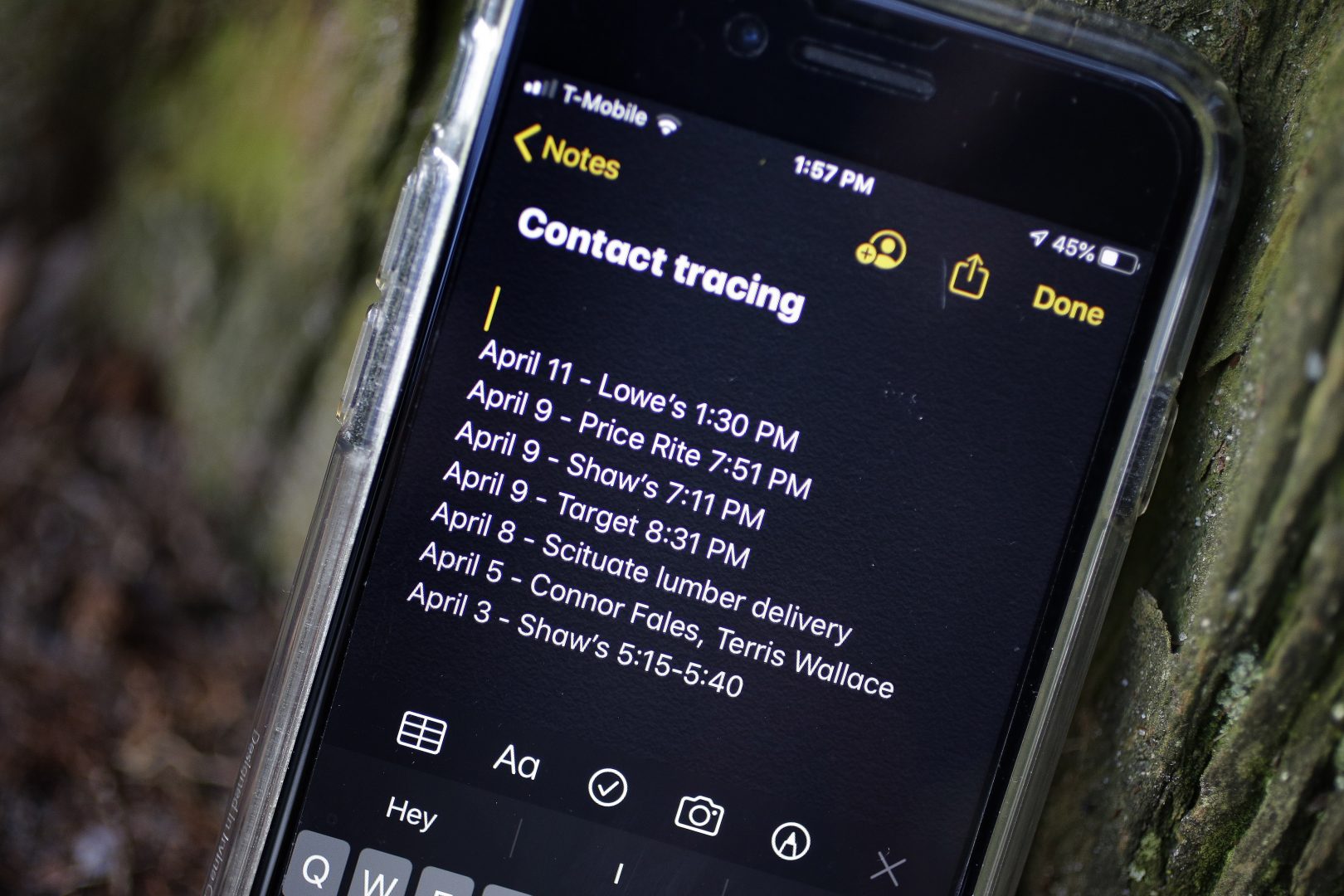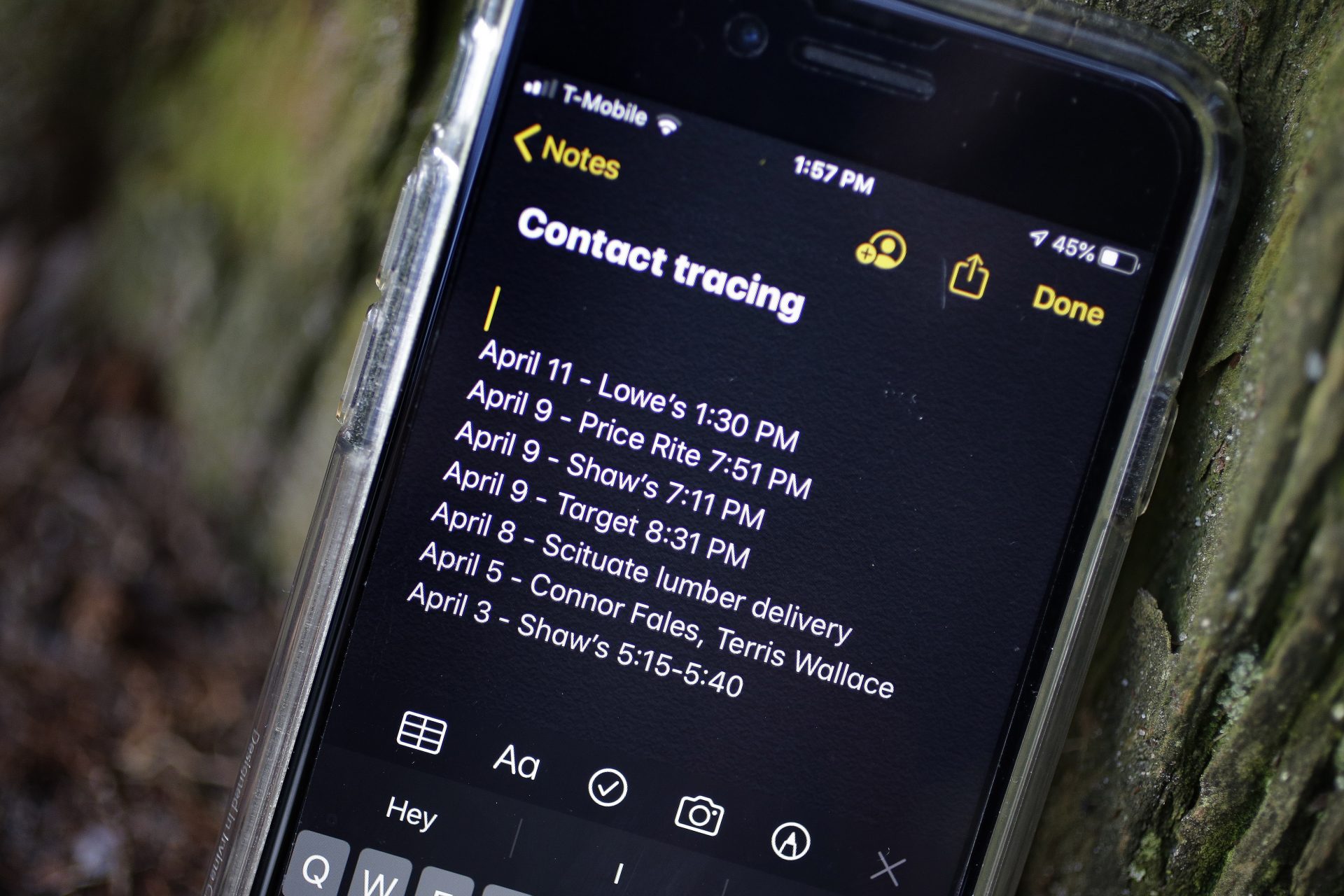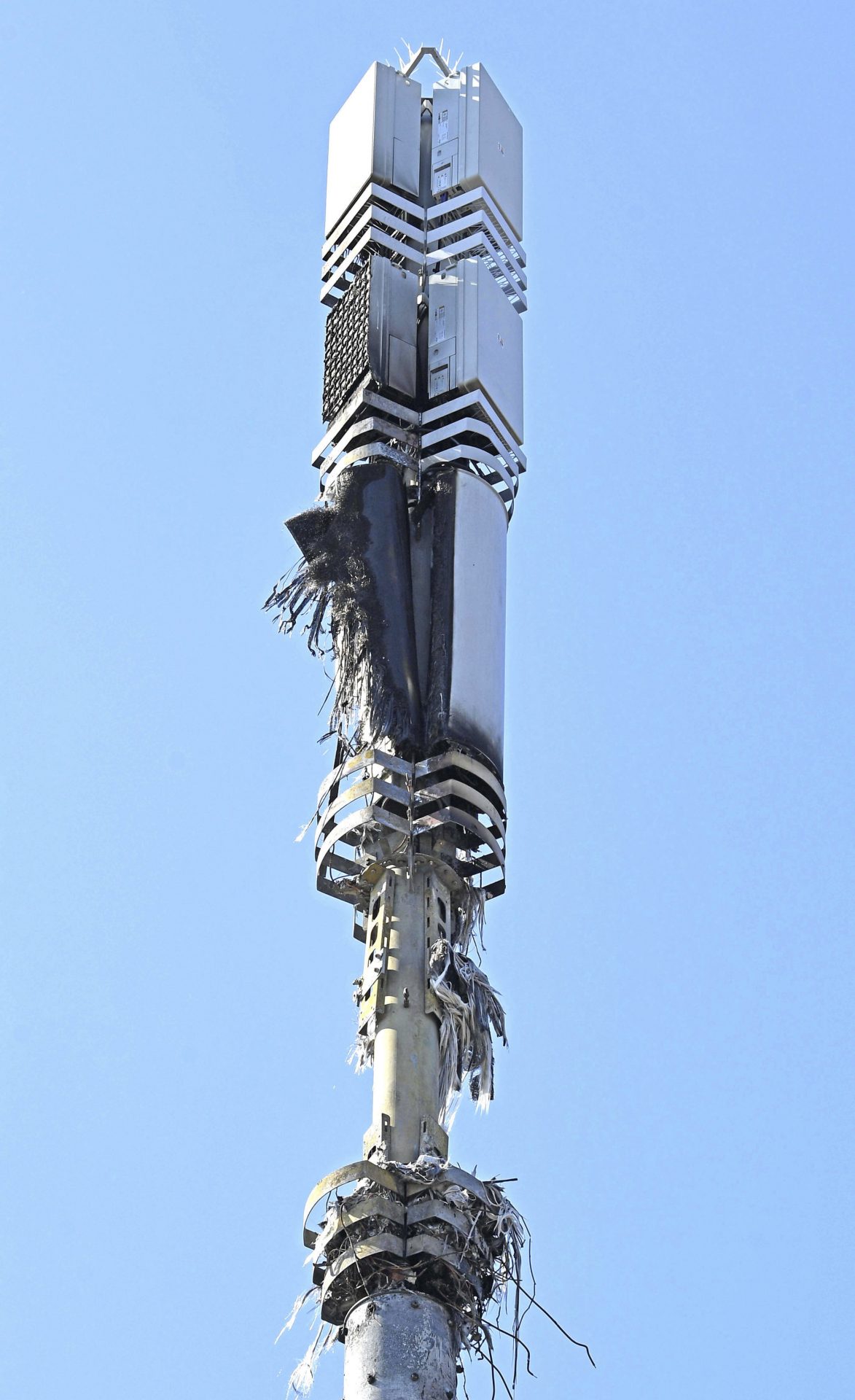
A smartphone belonging to Drew Grande, 40, of Cranston, R.I., shows notes he made for contact tracing Wednesday, April 15, 2020. Grande began keeping a log on his phone at the beginning of April.
Steven Senne / AP Photo

A smartphone belonging to Drew Grande, 40, of Cranston, R.I., shows notes he made for contact tracing Wednesday, April 15, 2020. Grande began keeping a log on his phone at the beginning of April.
Steven Senne / AP Photo

Steven Senne / AP Photo
A smartphone belonging to Drew Grande, 40, of Cranston, R.I., shows notes he made for contact tracing Wednesday, April 15, 2020. Grande began keeping a log on his phone at the beginning of April.

Steven Senne / AP Photo
A smartphone belonging to Drew Grande, 40, of Cranston, R.I., shows notes he made for contact tracing Wednesday, April 15, 2020. Grande began keeping a log on his phone at the beginning of April, after he heard Rhode Island Gov. Gina Raimondo urge residents to start out of concern about the spread of the coronavirus.
There are now 40,049 coronavirus cases across Pennsylvania, with 1,537 dead. The number of new reported infections has been averaging between 1,100 and 1,500 per day for weeks, and hospitals have, so far, not been overwhelmed by serious cases. As a result, the pressure to reopen the stateâs economy is building.
On May 1, construction projects will be allowed to resume, and on May 8 we could start to see some counties reopen.
But what will determine that?
Gov. Tom Wolfâs office issued more details on Saturday, which remain based on a metric announced earlier in the week, specifically: âA target goal for reopening has been set at having fewer than 50 new confirmed cases per 100,000 population reported to the department in the previous 14 days.â
âFor example,â Wolfâs office continued. âAn area with a population of 800,000 people would need to have fewer than 400 new confirmed cases reported in the past 14 days to meet the target.â
But reopening isnât just about how many cases counties have per capita, itâs also reliant on whatâs in place to keep track of the spread: âRobust case investigation and contact tracing infrastructure in place to facilitate early identification of cluster outbreaks and to issue proper isolation and quarantine orders,â Wolfâs office says.
The Associated Press reports that most states donât have much in place to do contact tracking, which requires in-depth interviews with people exposed to find out other possible exposures. In hard-hit Louisiana, there are only 70 hired to do that kind of work. In Pennsylvania, itâs unclear how many are needed, and even how many currently exist.
Among those people who are tasked with that are public health nurses, who are in charge of making the phone calls that notify people of their positive COVID-19 test. Spotlight PAâs Aneri Pattani takes you on a journey of what itâs like to make those calls to residents, the tedious repetition of the work and the heartbreaking stories they have to hear and sometimes counsel people through.
And while the state works out those specifics and counties keep an eye on case counts, veteran centers and hospitals are not looking too great, especially in the eastern part of the state. The Philadelphia Inquirer reports that veterans inside state-run nursing homes are âsitting ducksâ with the death count in one Chester County nursing home tripling in five days.

In this Tuesday, April 14, 2020 photo, a view of a cell tower after a fire, in Dagenham, England. Dozens of European cell towers have been destroyed in recent arson attacks that officials and wireless companies say are fueled by groundless conspiracy theories linking new 5G mobile networks and the coronavirus pandemic. (Stefan Rousseau/PA via AP)
The 5G mania: Coronavirus conspiracy theories are bountiful. I attribute it to all of us being glued to our screens and going down YouTube rabbit holes. But the most prevalent conspiracy theory â which has been debunked repeatedly â is that 5G wireless communications technology is somehow the cause of COVID-19, and not the novel virus SARS-CoV-2. And as my friend Danny Gold tweeted, âI guess sometimes itâs fine, people can believe their nonsense, you can have a laugh at your favorite YouTubers & podcasters, but overall it has a tremendously negative effect [on] society as this pandemic has shown.â For The New Yorker, an opinion piece on how this specific conspiracy theory is doing harm to public health efforts.
A daring escape from a nursing home: As the body count continues to rise in assisted-living facilities, family members are scrambling to try and figure out whatâs happening to their loved ones. But in New York, that has proved to be hard as the city hasnât released numbers and nursing homes have been tight-lipped on who gets ill in their care. For Frontline and ProPublica, watch as one daughter tries to learn what was happening inside a Queens Facility with her father, her daring act to get him out and save him.
Leave the guns at home: In a complete 180 to the anti-shut-down rallies we saw in Pennsylvania and across the nation, a Tea Party-backed group, The Convention of States, is attempting to do a makeover of the protests. The groupâs main advice: stop being crazy, and leave your guns at home. Mark Meckler, president of the group and also co-founder of the Tea Party Patriots, told Politico: âWhen people are engaged in politics, the question is: Do they want to accomplish their goals, or they just want to go out there and do crazy stuff? And so you can have the right end goal, but you can still act crazy in pursuing that goal. I’m not in favor of that.â
As Shaggy said, âIt wasnât meâ: I guess those affairs were bound to be found. But who wouldaâ thunk it was a pandemic that brought couplesâ issues to light. Turns out, as more couples are spending time together 24 hours a day, theyâre finding it harder to hide (or avoid) each othersâ vices.  As VICE reports, itâs hard to hide how many drinks youâve had if you canât go to a bar. And itâs hard to hide that side fling if youâre always by your partnerâs side. âTheyâre snooping,â one divorce attorney said. âTheyâre overhearing, theyâre listening. Affairs are gonna come out more because, âWhy are you locking yourself in your bathroom for so long?â You know what I mean? People arenât stupid.â
COVID-related stroke deaths: At this point, we all know COVID-19 is a respiratory illness. But hereâs something new: we now know itâs attacking every single major organ, including the brain. Doctors are reporting that otherwise healthy young people who contract the coronavirus but show no flu-like symptoms are showing up with severe strokes â an assumption that was first noted during Wuhanâs surge but is now recognized through more tests and analysis in the states. From The Washington Post: âWe are used to thinking of 60 as a young patient when it comes to large vessel occlusions,â one doctor said. âWe have never seen so many in their 50s, 40s and late 30s.â
Your best non-coronavirus Sunday reads, ranked with most interesting on top (in my opinion):
MEL Magazine:Â âThe Forgotten Tiger King of Harlemâ
New York Times Magazine:Â âMy Restaurant Was My Life for 20 Years. Does the World Need It Anymore?â
AFAR:Â âThe Great Barrier Reefâs Great Big Complicated Storyâ
Esquire:Â âThe Life And Death Of An Instafishâ
VICE:Â âThe Guide to Getting Into Cocteau Twins, the Hypnotic Dream-Pop Pioneersâ
The days of journalism’s one-way street of simply producing stories for the public have long been over. Now, it’s time to find better ways to interact with you and ensure we meet your high standards of what a credible media organization should be.